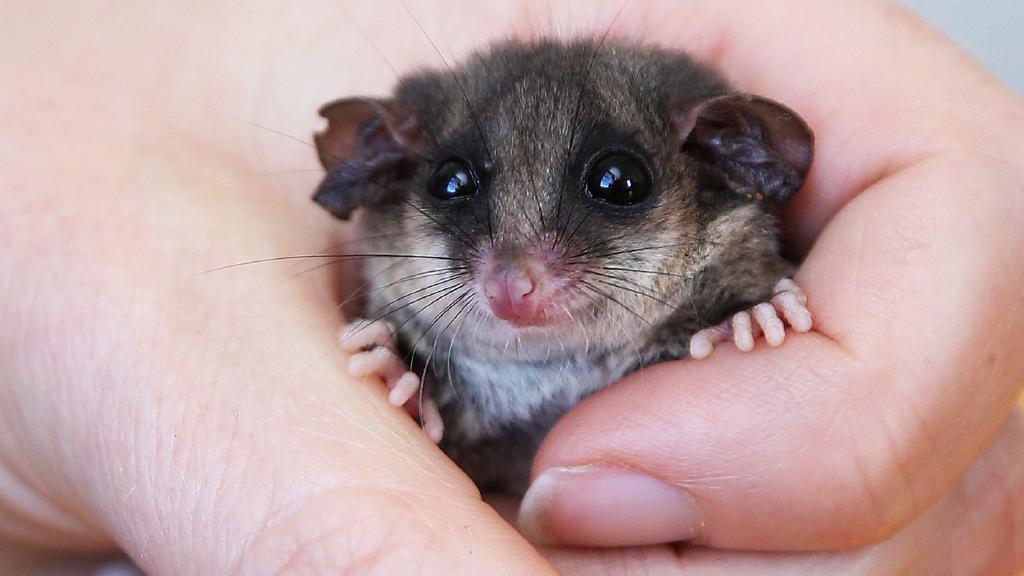I usually write about the plants and animals that we are likely to encounter in the backyard, or while walking through local forests, or walking the dog around our lakes. But this month, I wanted to introduce you to a very endearing little marsupial that lives in the Wombat Forest but is rarely ever seen.

The Eastern Pygmy possum has been photographed recently in a beautiful patch of forest south of Blackwood. The tiny possums were captured by an infra-red camera, one of several cameras stationed around thirty sites across the Wombat Forest by Wombat Forestcare team, as part of the Caught on Camera project. To the untrained eye, the little creature inspecting the bait in a tea strainer could be a bush rat, or an Agile Antechinus, one of the most common marsupials of the forest. But the Pygmy Possum has a quite different body shape to these animals, more stout and cuddly, bigger rounder ears, with a fat prehensile tail.
Eastern Pygmy Possums have a brush-tipped tongue; used to gather pollen and nectar from flowers such as banksia and tea-tree. When the banksias and other flowers are not in flower, the possums will eat invertebrates such moths, spiders, grasshoppers and beetles. The possums shelter in tree hollows, but they also make little spherical nest balls, woven from short, shredded bark and hidden in eucalypt tree bark, old bird nests and in shrubs such as tea trees… One pygmy possum may regularly use ten of these little dens!

This little guy was photographed during a reintroduction of Eastern Pygmy Possums to a reserve in Sydney called North Head, managed by the Australian Wildlife Conservancy – see here for more
The old names listed for the Eastern Pygmy Possum are so quaint: Common Dormouse-phalanger, Dormouse Opossum and Possum Mouse! The Dormouse name probably refers to the ability that pygmy possums have to go into torpor – a light hibernation. The possums roll into a tight little ball, with their ears folded down and their body’s internal temperature similar to that of the surroundings. They may spend large periods in winter conserving energy in this way, until the banksias come into flower again, or insect activity ramps up in warmer months.
There are several pygmy possum species around Australia, and surprisingly, the Eastern Pygmy Possum at 24 grams in weight is by no means the smallest of the group – the Little Pygmy Possum weighs only 7 grams! These little cuties are much more carnivorous than the Eastern Pygmy Possum – their favourite food is very small lizards. The most famous of the pygmy possums, the endangered Mountain Pygmy Possum uses this ability to go into torpor as a crucial survival tool in its alpine habitat, for up to seven months in the year. They are regarded as the only true hibernating mammal in Australia. And they are the biggest of the lot – at 41 grams.
The Eastern Pygmy Possum has a prehensile tail used for help when clambering about the flowers and branches. At this time of year, the base of the tail gets much thicker and is used as a fat storage area for the lean months.

Ellie the baby Eastern Pygmy Possum enjoys a mealworm, cared for by WIRES volunteers in NSW – Daily Telegraph
The Wombat Forestcare Caught on Camera project coordinators Ivan Carter and Gayle Osborne are delighted to have photographic records of the Eastern Pygmy Possum in the Wombat Forest. They are classified as Near Threatened, and are considered to be very sensitive to threats such as logging, cats and foxes, and planned burn operations. In five years of placing cameras in various parts of the forest, the pygmy possums have been spotted at just three sites. The possums have been found in Blackwood south, in a beautiful patch of forest which is shrubby foothill forest, and heathy dry forest with towering peppermints, mountain grey gums and candlebarks, and a diverse understory of banksias, hakeas and prickly tea-tree. Crucially, this area has not been burnt for at least a decade!!!
The pygmy possums have tiny home ranges, less than a hectare. One can imagine that a planned burn that covers hundreds of hectares has a devastating effect, as the removal of the shrub layer wipes out the food and shelter of any surviving pygmy possums.
I think it’s an absolute wonder there are any surviving locally at all! The Caught on Camera project is incredibly important – as some regard the Wombat Forest as not very good habitat compared to the Otways or the forests east of Melbourne. But Wombat Forestcare’s work has shown that there is a lot of life in our beloved forest – their cameras reveal populations of Mountain Brushtail possum or Bobuck, and of course the Threatened Brush-tailed Phascogale, previously unrecorded in the Wombat Forest south of Daylesford.
For exciting photos of all the Caught on Camera animals, “like” Wombat Forestcare on Facebook, or go to www.wombatforestcare.org.au
0 Comments